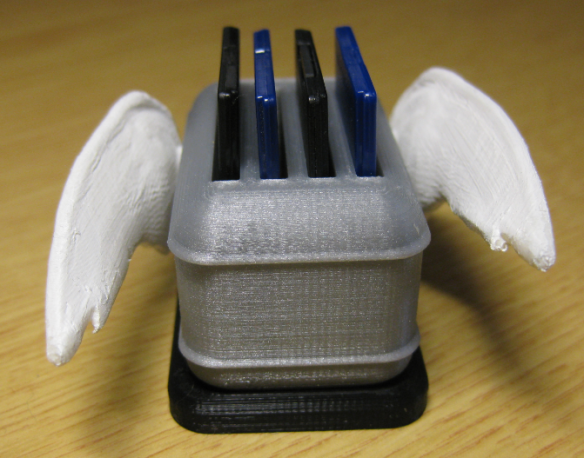Does everybody still know why in the ‘old’ days there was the need for running a ‘screen saver’ on the computer? With the modern LCD displays they lost their initial purpose. After “3D Printed Classic Mac Apple Watch Charging Station” I’m doing more ‘good old days’ 3D printing. The ‘elder ones’ might remember the “After Dark” screen saver software for Apple Macintosh and Microsoft Windows machines. Yes, that was 1991! For me most famous and iconic theme were the “Flying Toasters”:
Now there is a 3D printed version 🙂
If you want to try it out: There is a web-based version on http://www.masswerk.at/flyer/flyer.html to get back the feeling from these days!
For many of my embedded projects I use SD cards (see “FatFs with Kinetis“), and having the cards laying on my desk is a mess! So why not storing them in a flying toaster?
The model is on Thingiverse:
It includes optional wings 🙂
I have printed the parts with a Ultimaker 2 using PLA at 0.1 mm with no support structure. I used different PLA (silver, white and black) for the different parts:
Then glued the parts together.
The model and design files are available on Thingiverse here.
Happy Toasting 🙂










Those born to crawl – will never fly! ))))
LikeLike
with imagination it will always fly 🙂
LikeLike
Hi, Erich
Did you use Flexnvm as EEprom in MK20DX256_10?
my question is how to “pre-erased” ?
LikeLike
Hi Henry,
nope, I have not pre-erased K20DX256 in a toaster 😉
Seriously: I have not checked it, but I think that when you download the application with the debug probe, the FlexnNVM gets erased too?
Erich
LikeLike
thanks a lot, in AN4282 page 15
“The EEE can also be pre-erased by writing 0xFF to the EEE data locations. Pre-erasing locations help to reduce the programtime because it guarantees that an erase cycle will not be needed. Typical program time to a pre-erased data location is ~100 us. This feature allows for quick data logging in time critical situations”
how to understood for this “pre_erased”
thank you for quikly reply
LikeLike
Ah, I see 🙂
I understand it like this: You write 0xFF to the EEE when you have enough time in your application (e.g. before start logging data to the EEPROM). That way the EEPROM cells are already ‘pre-erased’. Now when you start logging and writing data, the EEPROM cells are already erased (set to 0xFF) so the write operation does not have to do it (because it is pre-erased), thus resulting in faster EEPROM write time.
I hope this makes sense?
Erich
LikeLike
I don’t think we can write data to same location inside DFlash every time,
“When configured for EEPROM use, writes to an unprotected location in FlexRAM
invokes the EEPROM file system to program a new EEPROM data record in the
EEPROM backup memory in a round-robin fashion.”
LikeLike
This only says that when you write to FlexRAM it will trigger a write transaction to the EEPROM. You are free how many times you want to to this. So you could write 0xFF to the FlexRAM to pre-erase it.
LikeLike
thanks, the answer is really helpful
LikeLike
Doesn’t the heat from the toaster damage the memory cards??? lol
LikeLike
Yes, if you set the temperature too high, your data gets toasted. So be careful, and set the toast level to ‘light’ or ‘light to medium’. I have found that software (like source files) get faster toasted than hardware files (schematics, PCB layouts, …). So be sure you adjust the toast level based on the SD card content.
😉
LikeLike
Pingback: Hackaday Links: January 7, 2016 | Hackaday